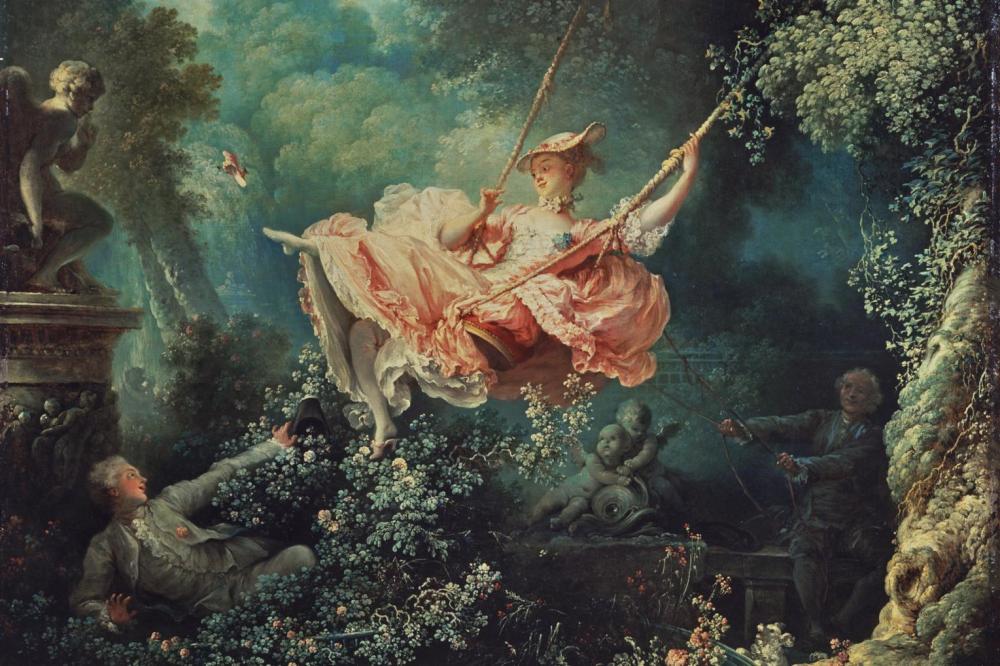Fragonard was one of the finest painters of the French Rococo period during the reign of Louis XV. French tastes were determined by Louis and his famous mistress Madame Pompadour. Louis’ grandfather Louis XIV, the “Sun King,” was recognized for leading France’s lavish Baroque lifestyle. Still, probably for the redemption of his soul, he changed in the last years of his reign to a stern and puritanical lifestyle for himself and his court. After this very restrictive and solemn lifestyle, Louis XV ushered in an era of extravagant hedonism, which was welcomed heartily by the nobility. Art and life changed from the deep rich colors of the severe and baroque religion art to soft and sensuous pastels and subjects of pleasure, amusement, and a Rococo soft eroticism. Mythological themes replaced the serious and moral subjects of Catholicism. The new preference was for fairytales, fantasy and as I often say, they preferred to look at the world through rose-colored glasses, thus the new popularity of pastel colors.
This was the era of Fragonard. In the city of Paris, the aristocracy built lavish townhouses, and in them, they began in 1737 to hold Salons. These new settings needed appropriate decorative accompaniment. Throughout his career, Fragonard had a close and loyal group of patrons from the court. He painted both large scale decorative works for display in their lavish townhomes and small erotic cabinet pieces for their more private spaces and tastes.
In 1752 Fragonard won the coveted Prix de Rome, which paid for his study and time in Rome from 1756- 61. In Rome, he began to develop his style and was able to tour Italy. He was struck by the lavish gardens, fountains, and antique Roman ruins on the sprawling grounds of estates such as the d’Este Villa in Tivoli. These made an indelible impression on him and served as imaginary settings for his art.
Two of his paintings, entitled The Swing, illustrate the two styles of the Rococo. 1775-80, The Swing, is one of a series of four in the National Gallery in DC. We see an expansive garden where the court spends its time playing, picnicking, flirting, and enjoying life. The colors are pastel, the sky is blue, the trees are more like big plumed fans, and the aristocrats do not have a care in the world. The series illustrates games of Horse and Rider, Hot Cockles, and Blind Man’s Bluff. Take note they are all delightful children’s games, and elaborate setting for simple pleasures are the themes of Rococo art. Portraiture, not Fragonard’s forte, was still popular, but the sitters frequently chose to be portrayed in costumes as mythological figures, not as themselves.
The second The Swing of 1776, is an example of the more intimate and private work. In a setting of fluffy trees in an ancient garden, a lovely maiden swirls her frilly apricot skirts and petticoats high, as she is being pushed on her swing by an elderly Bishop. Knowingly she lifts her legs as she swings forward to give her admirer, hiding in the bushes, a glimpse up her skirt. Oh my! She even tosses him her shoe as a souvenir. Complicit in the charming secret are two sculpted putti on a dolphin fountain, known companions of Venus. A sculpture of Cupid, at the left, is watching joyfully and shushing us to keep the secret. Rococo eroticism was very soft porn.
Fragonard was married to Anne-Marie Gerard, and they had two children, both he taught to paint. As he aged his wife’s sister, Marguerite Gerard came to live with them and became his most able assistant and a notable painter on her own.
If you have been noticing the date of the two paintings, 1776, the Rococo period, the King and the court’s laze-faire attitude would come abruptly to an end. The success of the American Revolution spurred on the French revolution of 1789. Fragonard left Paris and returned to his place of birth, Grasse, on France’ southern coast. [Consequently, Grasse, where the mountains are covered with roses and flowers, was a center for the perfume industry of France, which still flourishes.]
Poverty forced Fragonard to return to Paris in 1793. Jacques-Louis David recognized his previous fame as an artist, the painter of the revolution, and David appointed him a curator of the new national museum of art. On his death, he left more than 550 paintings and hundreds of wash illustrations, which he made for several book publishing projects.
Beverly Hall Smith was a professor of art history for 40 years. Since retiring with her husband Kurt to Chestertown six years ago, she has taught art history classes at WC-ALL and Chesapeake College’s Institute for Adult Learning. She is also an artist whose work is sometimes in exhibitions at Chestertown RiverArts and she paints sets for the Garfield Center for the Arts.





Write a Letter to the Editor on this Article
We encourage readers to offer their point of view on this article by submitting the following form. Editing is sometimes necessary and is done at the discretion of the editorial staff.